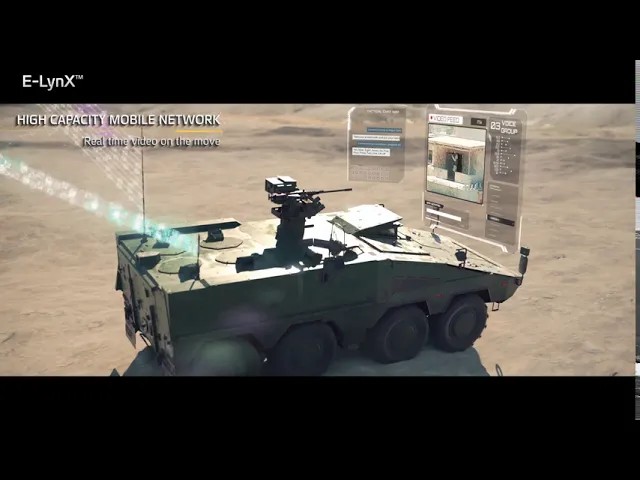Introduction
Many nations are currently at different stages of implementing digital modernization of their armed forces. Elbit Systems partners with MoDs to jointly realize the vision of a multi-dimensional networked combat C4ISR system. The sections below share some of the cumulative lessons learnt through C4ISR projects executed over the last two decades, and the challenges of military radios and technological developments.
The heart and enabler of this C4ISR system is the tactical network – an integrated mobile and deployed IP WAN, interconnecting all combat and command, land, air and sea elements in the theatre, and connecting to the upper level fixed network and adjacent coalition WANs.
Network Goals
The C4ISR Network needs to be capable in terms of capacity and latency; it must be efficient in its use of bandwidth and spectrum and adaptive to changes in network conditions. The network has to be secure against EW and cyber threats as well as manageable – able to be set up and used by staff with limited technical expertise. It should be interoperable with upper echelon, adjacent coalition and existing legacy networks, and standard in its interfaces to simplify integration. And finally, it has to be affordable in terms of procurement and operation costs.
Network Services
The C4ISR network must deliver voice (PTT all-informed voice groups and cross-network telephony-like calls), data (unicast, multicast and geocast (area-of-interest based messaging), video (unicast and multicast multi-hop) and low-latency services (sensor to effector loop, IAV control). A network planning and management service is needed to setup and support the above services.
Network Integration
Achieving an integrative tactical network required acknowledging and addressing challenges in three main areas: Technology (waveforms, routing protocols, tactical QoS, enterprise and legacy radio integration), Operations (how to plan, setup, use and maintain the mission network), Programmatic (defining roles and relationships between equipment vendors, customer stakeholders and network integrator). In this discussion we will focus on the technological challenge of tactical routing and QoS.
Tactical Routing Challenges
The routing challenges that need to be addressed by a tactical router interconnecting mobile radios are very different from those encountered in enterprise routing. These include:
- Limited capacity – technology is advancing and bringing higher-capacity radio networks to the lower tactical echelons, but at the same time, application information exchange requirements are growing even faster.
- Dynamic capacity – tactical network capacity fluctuates dramatically over time and will typically be affected by range between nodes, topography and additional radio frequency (RF) characteristics.
- Heterogeneous network behavior – The different network types that comprise the tactical network have different levels of performance. The router needs to be aware of the capacity of the radio network and to differentiate the flow of application traffic to the radio in accordance with its capacity.
- Dynamic Topology – the tactical network is mobile, with mesh networks forming and breaking as mounted and dismounted nodes travel through the battlefield, as well as singular nodes leaving and joining networks due to motion or topographic conditions. The high frequency of topology changes, together with the limited overall network bandwidth means that routing protocols must be extremely efficient in order not to use up all available network capacity just to keep the network alive.
- Appropriate Networking Standards – current industry-adopted protocols and standards do not adequately address the full range of needs or enable delivery of the level of performance and efficiency that is crucial for the tactical network to function effectively. Recent work led by NATO Science and Technology and leading EU academic institutes have recognized this and initiated follow-on studies to try to define solutions.
- Network Through-Life Support Costs – through the programmatic lifetime of a tactical network, there will typically be multiple updates in waveform versions, introduction of new radios and waveforms as well as new applications and version updates to existing ones. An integration approach that has proved cost/effective is to have a routing middleware that is the integration point for all applications and for all bearers, so that there is no need for each application to integrate separately with each bearer.
Elbit, as a leader in the field of tactical networking for over two decades has developed a routing suite of services that successfully addresses these challenges.
Elbit TIGER Routing Service

TIGER is a software service that serves as a middleware layer between the application la
yer and the radio layer. Its key tasks are to:
- Build and maintain the tactical network topology
- Provide suitable quality of service to applications over tactical networks
- Regulate flow of traffic to bearers to ensure network does not become overloaded
- Increase effective bandwidth utilization
- Abstract the application layer and the bearer layer to each other
TIGER can be seen as a standard network IP router with a set of additional enhanced capabilities that are necessary to overcome the limitations of tactical radio networks. This dual-stack approach enables applications to utilize the tactical routing service in a very standard way in areas of the network that are less challenged, and to gain access to additional services optimized for the challenged areas of the network through an application-aware interface or services API. Using the latter enables the application to convey to the router, together with the data packets it tranmits, some meta-data describing the nature of the packets to aid the router in its routing and quality-of-service decision making.
Over the last two decades, Elbit has been successful in implementing scalable tactical networks in NATO and 5-eyes armies, integrating modern SDR radio technology, legacy radio and fixed IP network infrastucture. A key enabler of these networks has been TIGER, that has evolved during this period through multiple cycles of design-implement-field-learn. Today it is quite clear that any large scale, dymanic mobile WAN integrating multiple instances of tactical bearers will need to be based on a TIGER-like solution.
Military Radios
Terrestrial communication in general and tactical communication network for maneuvering troops in particular, require unique characteristics in order to enable reliable and robust communication in numerous challenging connectivity scenarios. Network members usually operate within groups such as tank crews or various battalion roles, where these activities often require close physical presence of several nodes on the network. For example, scenario such as tanks and armored personnel carrier (APC) are located a few meters apart from each other and must support all communications services among themselves and with other groups on the network, operating with high transmission power and in adjacent channels. In order to meet this typical “near-far” scenario (communication with a distant unit at maximal range, simultaneously with a nearby unit operating on adjacent channels), the radio system is required to combine two key RF features – high selectivity and wide dynamic range. The receiver dynamic range determines the adjacent channels power difference between the level of the strongest signal and the level of the weakest signal that can be received. The receiver selectivity determines the attenuation level of undesired signals that are outside the bandwidth of the desired signal.
Co-existence with other communication systems operating on the same or in the near vicinity of a platform is another major challenge. A vehicular platform will often have multiple communication systems operating in nearby frequencies or bands, were the transmission of one system is received at a very strong level over the antenna of the other system (as high as 30 dBm), while need to maintain receiver signal sensitivity of as low as -100 dBm.
A radio designer should take these into consideration and provide high selectivity and wide dynamic range values by combining both analog and digital measures. These will also allow a more efficient utilization of a scarce resource – the spectrum.
Modern battlefield communication demand an ever increasing user data rate. While in the past focus was on elementary speech capabilities with additional limited data, nowadays waveforms and networks are required to support wide traffic for increased number of voice groups simultaneous with various services, including multiple high capacity video streaming. Other features such as ultra-low latency (e.g. for unmanned applications), are also a part of these new waveform requirements.
Data rates can be increased by utilization multiple RF channels simultaneously. However, multi-channel simultaneous reception, when implemented in half-duplex radios, is not efficient for scenarios where channel reception is required in parallel to continuous transmission. Such half-duplex radio, which allows either transmission or reception at a given time, derives severe limitation on the allocation of channel resources, so that the transmission duration of each member are adjusted and do not conflict with the required reception duration. In a network with high number of members that is operated by a half-duplex regime, in order to allow traffic between members, it is necessary that at any given time only a single member will transmit (to prevent non-reception of the transmissions). Therefore, in such high dynamic traffic network, half-duplex multi-channel radios are often inadequate. Half-duplex limitation becomes an even more significant when it is required to operate multiple waveforms simultaneously over a single radio unit, with the need for unsynchronized transmission and reception between the waveforms. The solution is to use full-duplex radios that allow full utilization of multi-channel reception in parallel with multi-channel transmission.
Multi-channel radios and specifically radios with full-duplex capabilities raise numerous technological challenges. In order to effectively implement the multi-channel capability, channel filtering (both analog and digital) is essential per each multi-channel for mitigating interference. Such filtering provides RF reception with high selectivity and wide dynamic range per each channel and reduces the transmission noise in the adjacent channels. Such filtering must be efficiently implemented, to support large frequency range and fast frequency hopping, while maintaining a small form factor for vehicular and portable radio configurations.
Challenges intensify even more when dealing with full-duplex, as transmission and reception are performed in adjacent channels and by antennas very close apart (over the same vehicle, or even carried by a soldier). In such cases, the transmitter adjacent channel leakage power significantly increases the reception noise floor. To overcome this Self-Interference Cancellation (SIC) technology, operating both in the analog and digital domains should be implemented.
The multi-channel and full-duplex technologies, while operated with a multi-channel waveform, can significantly improve the Mobile Ad Hoc Network (MANET) performance. Data throughput capacity allows dozens of Mbps per node (single radio unit), and higher bitrates per network. Yet, multi-channel waveform enhancements are not limited to higher capacity alone, and also derive capabilities such as scalable agile and dynamic networks, higher number of members, higher number of voice groups, lower latency, superior spectrum efficiency unitization, improved cognition and enhanced immunity.
Multi-channel full duplex radios may also support operation of simultaneous waveforms over a single platform. This simplifies connectivity between different networks, using either internal or external router, and improve various scenarios, such as Manned-Unmanned Teaming (MUM-T).


